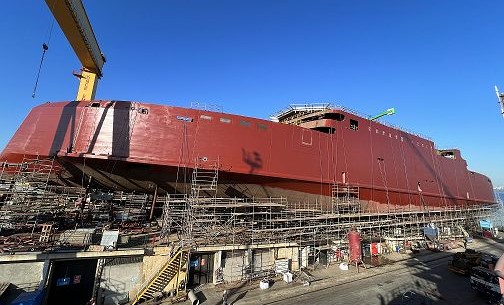Scandliness new zero direct emissions ferry takes shape

It needs a few finishing touches, but it's definitely starting to look like a ship.
All 36 sections that make up the new Scandlines zero direct emissions ferry are welded together, with the exception of the bridge, which will be placed in the centre of the vessel.
The freight ferry, which will be deployed on the Fehmarn Belt between Puttgarden in Germany and Rødby in Denmark in 2024, has now been primed and the various compartments are gradually being filled with equipment.
As the ferry, carrying the working title PR24, will also be able to operate as a hybrid ferry, three GenSets (a combination of a diesel engine and a generator for power production) from the manufacturer MTU have been installed.
However, the world's largest lithium-ion battery bank to date, totalling 10 MWh from the Swiss manufacturer, Leclanché, will only be installed just before the ferry is delivered.
The 8.6 metre high ferry charger tower, developed by the German company, StemmannTechnik, is being prepared for installation on the mole edge at ferry berth 3 in Danish Rødbyhavn.
The system stores the latest position of the ferry, so it is expected that only minor adjustments to the position of the charging pantograph will be required for each ferry call. The ferry charging system is able to compensate for changes in water level and ferry movements.
As the ferry approaches the berth, the charging station is activated, the tower gate opens automatically and the charging plate extends. Once the ferry has moored in the berth, the charging pantograph connects to the onboard unit within a maximum of 15 seconds and starts charging the batteries. After charging, the tower gate rolls down again to protect the components from external influences.
The transformer, control and switch gear equipment are already in place at the ferry berth in Rødbyhavn, and soon the ferry charger tower for the new ferry will also arrive.
Data for zero direct emissions Scandlines freight ferry for the Puttgarden-Rødby route:
- Length: 147.4 m
- Breadth: 25.4 m
- Design draft: 5.30 m
- Freight capacity: 66 freight units (abt. 1,200 lane meters)
- Max. number of passengers: 140
- Service speed: 16/10 knots
- Crossing time: 45 minutes (as of 2025)
- Battery system: 10 MWh
- Charging time in port: 12 minutes (as of 2025)
- Direct emissions during the crossing: 0
- Investment: 80 MEUR
